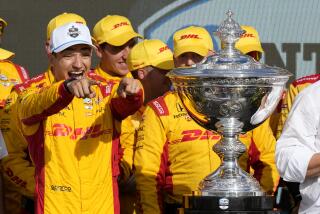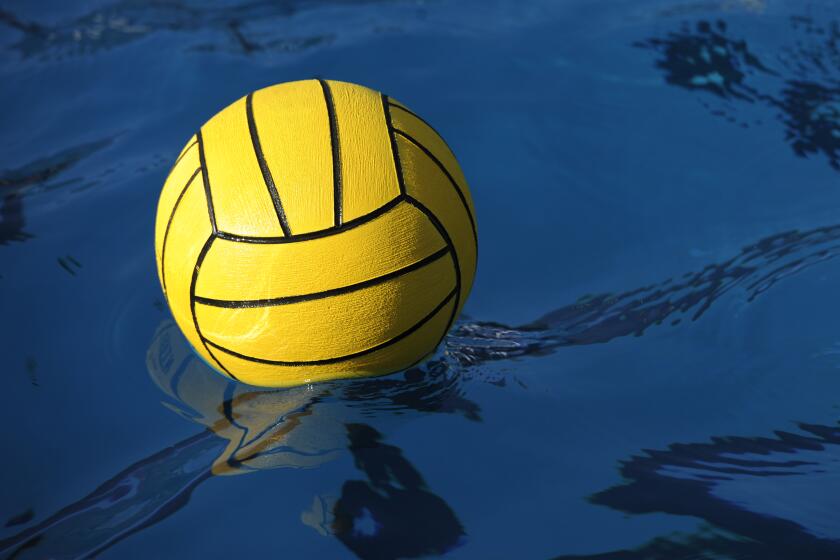NASCAR’s First Family
The thing I say over and over is that the success of NASCAR is that it has been the recipient of a two-generation benevolent dictatorship. -- Jack Roush, team owner, engine builder
*
For the record:
12:00 a.m. April 24, 2003 For The Record
Los Angeles Times Thursday April 24, 2003 Home Edition Main News Part A Page 2 National Desk 1 inches; 36 words Type of Material: Correction
Motor racing -- The NASCAR awards banquet was held last December in New York. A sports article Monday on the France family, a guiding force behind stock car racing, incorrectly said the banquet was last January.
Stock car racing, NASCAR style, ranks second only to the NFL in popularity among this country’s sports fans, and as Roush says, it has been successful because of the France family dictatorship, first Big Bill and then Bill Jr.
When William Henry Getty France, a broad-shouldered, 6-foot-5 bear of a man known as Big Bill, founded NASCAR with a few friends in 1948, it was an era of family ownership -- the Comiskeys, Wrigleys and O’Malleys in baseball, the Maras, Halases and Reeveses in football.
Five decades later, in an era of corporate sports ownership, the France family remains inviolate.
Small inroads have been made -- Mike Helton was named president of NASCAR, the first person outside the family to attain that position, and George Pyne was named chief operation officer earlier this year -- but the roll call of the board reads: Bill France Jr., chairman; Jim France, Brian France and Lesa France Kennedy, along with Helton and Pyne.
It all started when Big Bill, his wife Anne and baby son Bill Jr., were driving down from Washington in 1934 to make their home in Florida. Legend has it that they stopped in Daytona Beach because the car broke down, but France said later that they stopped because he wanted to watch Sir Malcolm Campbell attempt a world land-speed record in his Bluebird car on the hard-packed sand of Daytona Beach.
France was so infatuated with the racing tradition of the area that shortly afterward he entered his car in a race on the beach. He finished fifth, but when Daytona Beach city fathers said they’d lost money and would not promote another race, Big Bill said he’d like to put one on and eventually found a restaurant owner to help finance it.
It was a success and France was on his way. One major obstacle was the lack of faith that the drivers -- mostly bootleggers who hauled moonshine out of the Carolina hills during the week -- had in promoters. It wasn’t unusual for a promoter to abscond with the gate receipts in the middle of the main event.
For several years, France became more a promoter than driver -- making sure the drivers got their money -- but his career was halted by World War II.
Once the war ended, he returned to promoting, more determined than ever to organize stock car racing. One idea led to another until Dec. 14, 1947, when France and several friends founded the National Assn. of Stock Car Auto Racing in the Streamline Hotel near the old beach course.
In a few years, he bought out his partners. NASCAR has been a France family treasure since.
After shepherding the series through its growing pains, Big Bill decided to pass the reins to a younger man. He found him sitting across the kitchen table in Bill Jr., or Billy as his dad called him.
On Jan. 11, 1972, France, 62, turned over the presidency to Bill Jr., 39, and the young scion held the reins until Helton was introduced in 1999 as president.
When Bill Jr. took over, younger brother Jim, then 28 and more interested in motorcycle racing than cars, was named executive vice president of NASCAR and president of International Speedway Corp.
Third-generation relatives are now heavily involved, Brian as vice chairman and Lesa France Kennedy as president of ISC. They are Bill Jr.’s children.
A look at sport’s racing monarchy:
Bill France
France’s word was law as he cleaned up the ragtag sport, writing rules, guaranteeing that purses would be met, and scheduling races on Sundays so the moonshiners could race on their day off.
But if anyone wondered if Big Bill was a dictator or not, he could ponder these situations:
* Curtis Turner, at the time one of NASCAR’s biggest stars and later named one of its top 50 drivers, tried to unionize the drivers. France responded by banning him for five years, from 1961 to ’65.
* Richard Petty led a boycott of Talladega superspeedway when it opened in 1969 after he and other drivers claimed it was too dangerous. France, then 59, responded by buying a racing Ford from John Holman and lapping the high-banked track at 176 mph.
When that didn’t satisfy the drivers, who had formed something called the Professional Drivers Assn., and they still refused to race, France rounded up a group of lesser-known drivers from other organizations and had his race.
Curiously, one of them was Richard Childress, an independent driver from Winston-Salem, N.C., who later became Dale Earnhardt’s team owner and one of NASCAR’s most influential leaders.
All the big-name drivers were back for the next race.
* In 1965, when Chrysler showed up with a 426-cubic inch Hemi engine and neither Ford nor General Motors had anything competitive, France responded by changing the rules and outlawing it. Chrysler pulled out of the series, taking with it the No. 43 Plymouth driven by Petty, the defending champion.
Before the year was out, Petty and Plymouth were back.
* Glenn Dunaway’s car owner sued NASCAR in 1949 after his car had won a race but was disqualified for a non-approved chassis. He claimed NASCAR had no right to make such a decision.
France responded by winning the landmark case, assuring NASCAR the right to write and enforce its own rules.
“The case only involved $1,500, but it drug out for five years,” Bill Jr. recalled. “It was a case we had to hang with, despite the expense of time and money, because it was important philosophically. It was a case we had to win to continue as we have all these years.”
Big Bill died June 7, 1992.
Bill France Jr.
The day the first NASCAR race was held on the old beach-road course in Daytona Beach, Little Bill -- he is six inches shorter than Big Bill -- swept out the floors. It was 1948 and Junior was 15.
“I did just about every job there was to do,” France said. “I even raced a few times but not enough to get serious. I’ve been a corner worker, a flagman, even chief steward. I think to run a sanctioning body like NASCAR, it’s important to have that background.”
Nevertheless, when Junior assumed the presidency, the perception was that Big Bill was giving his son a title, but that he would still be running the show.
It didn’t work out that way. The quiet young man who had toiled in the long shadow of his father had a mind of his own and soon had the respect of the men along pit row -- the drivers, crewmen and owners.
“They’re two different cats,” Petty said of the Frances. “You could talk to Senior all day long and then he’d do what he intended to do in the first place.
“Junior, you can talk to and he’ll listen to you. He’ll talk to some other cats too, and he’ll weigh the pros and cons and then make his decision.”
The day he became NASCAR president, young France said, “NASCAR has a three-point philosophy governing rule making: safety, low cost and competitive racing.”
He has never deviated from that philosophy.
His legacy, however, may be in expansion. Before he took over, NASCAR was primarily a Southeastern regional sport with nearly every driver from the Carolinas, Alabama or Tennessee.
True, there were races at Riverside as early as 1958, and NASCAR ran a race at Carrell Speedway in Gardena in 1951 that Lou Figaro won in a Hudson, but NASCAR still had a “good ol’ boys from Dixie” atmosphere.
Coinciding with Bill Jr.’s promotion to president was the arrival of R.J. Reynolds Tobacco Co. with its Winston Cup points program. Until then, many drivers drove only in selected races, paying little or no attention to the championship.
“To expand nationally, we had to make sure our name drivers would compete,” France said. “When RJR started putting up a lot of bonus money, and we went to New York for the banquet, the points became important and all the drivers were in every race.”
France was stricken with cancer in 1999, then fell and broke his hip last year, and had triple-bypass surgery as well.
“On average, I feel pretty good,” he said. “It’s like if you put your feet in a deep freezer and your head in a microwave oven, on average you feel pretty good.”
He missed a few events, one of them last January’s New York awards banquet, but at Daytona a month later he was his usual feisty self, entertaining listeners with pithy remarks about Bruton Smith, his chief racing antagonist.
“Did you ever notice, when Bruton opens his mouth, he sounds constipated?” he said to guffaws.
When asked if NASCAR’s new $100-million Research and Development Center in Concord, N.C., was a reaction to the death of Dale Earnhardt and three other drivers in 2000 and 2001, he bristled and said, “We haven’t changed our approach one bit, we’re just more proactive about publicizing and bragging about it. As far as our commitment to safety, we have always had it as our highest priority. It’s nothing new.”
But he is slowing down now, and the France mantle is being handed down to younger brother Jim, son Brian and daughter Lesa.
Jim France
It’s not NASCAR -- it comes under the International Speedway Corp. umbrella -- but Bike Week and the Daytona 200 have nearly as much impact on motorcycling as Speed Weeks and the Daytona 500 have on auto racing.
That has been Jim France’s passion.
He raced in his younger days as a hobby, but he never stopped working at the racetrack, even as a college student at Florida Southern and as a soldier at Ft. Bragg.
“I flagged a U.S. Grand Prix motorcycle race when I was on vacation in college, and I was at Talladega for groundbreaking while I was in the service,” said Jim, now 58.
Major projects for the future include having a sponsor in place -- or at least in mind -- if and when RJR pulls the plug on its Winston Cup involvement, and expanding the premier series into New York and other areas.
“If we are to continue to grow our sport nationwide, we need to get into places like New York, Denver, Portland-Seattle and Minneapolis,” France said. “Once, 90% of our tracks were in the Southeast. Now it’s about 50% and that’s too many. New York is a long-range project, but we’re working on it.
“As for replacing Winston, there is money out there. Look at Formula One. Their major sponsors spend more money on one team than RJR does on the whole Winston Cup season. Put in that perspective, I think the prospects look bright in case RJR drops out in 2007.”
In the meantime, France keeps busy helping expand Bike Week.
“I’m more interested in motorcycles because I used to race them and still ride one. It doesn’t get the publicity, but around here [at Daytona], it’s just about as big as the cars,” he said.
“I’d like to see the races in California Speedway get as big as ours. If we can just get the public out to see them, I think it could happen.”
Brian France
A key player in NASCAR’s marketing program, Brian is rapidly moving up the corporate ladder. Last December he was promoted from executive vice president of NASCAR to vice chairman, a title he shares with his Uncle Jim.
It is Brian who spearheaded the marketing of NASCAR related items, such as caps, shirts and jackets, now worn by nearly every spectator at the races. Only the NFL has higher attendance. Since he took over marketing in 1994 his staff has quadrupled, and new offices have opened in New York, Charlotte and Los Angeles.
Lesa France Kennedy
Recently named female sports executive of the year by Street & Smith’s SportsBusiness Journal, Lesa, 41, is president of ISC.
Her crowning achievement was the creation and design of DAYTONA USA, a 50,000 square-foot Disney-like tribute to stock car racing that has become one of Florida’s major tourist attractions.
“Fans used to come to our office and ask what else there was to see, other than races, so I started asking around about what people would like to see,” she said. “What came out of it was the Ultimate Motorsports Attraction.”
Her first job, at 14, was working in the ticket office with her grandmother.
“I never was involved much on the racing side, I was more into the business of the sport,” she said. “I don’t even get to see the races because I’m usually working inside an office somewhere. So even though I’m around it all the time, I never became much of a race fan.”
One of her other major accomplishments, though, was directing construction of Kansas Speedway.
J.C. France
Jim’s son, 37, is into racing, but as a sports car driver, not an administrator. Last month he and veteran Hurley Haywood won the Grand Prix of Miami, sharing the wheel in a Porsche-powered Daytona Prototype for Brumos Racing.
“Jamie worked in the concessions at the speedway for a while, but he was more interested in becoming a race driver at 35,” Jim France said.
When Skip Barber opened a driving school in Daytona Beach, J.C. earned his racing license.
“My goal at that point was just to buy a ride in somebody’s car, just to say I competed in the Rolex 24,” he said. “When the Brumos deal came along, it was a complete shock to me, and I, of course I was overly thrilled to have Hurley as my co-driver. I was there [in 1975] when Hurley and Peter Gregg won their first 24 Hours in the No. 59 Brumos car.
“It was an absolute blast to win the race. I’ll never forget being in Victory Lane on top of the podium for the first time. Now my goal is to win the Rolex 24.”
France’s next outing, with Haywood, will be May 3 for the Phoenix 250 at Phoenix International Raceway.
Next in Line
Maybe it will be Ben Kennedy, 11, the son of Lesa and Dr. Bruce Kennedy.
“He hasn’t started work at the speedway yet, but it probably won’t be long before he’s shagging something for one of us,” said his mother.
*
Fontana Facts
* What: NASCAR racing, Friday through Sunday.
* Where: California Speedway, Fontana.
* Friday: Winston Cup qualifying.
* Saturday: Busch Grand National Auto Club 300, 1 p.m., Ch. 11.
* Sunday: Winston Cup Napa Auto Parts 500, 11:30 a.m., Ch. 11.
More to Read
Go beyond the scoreboard
Get the latest on L.A.'s teams in the daily Sports Report newsletter.
You may occasionally receive promotional content from the Los Angeles Times.










